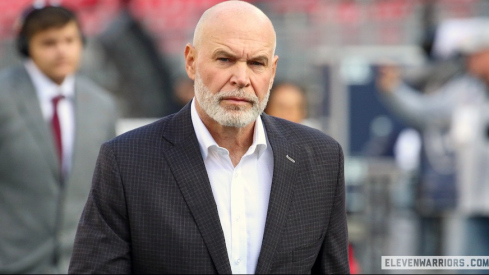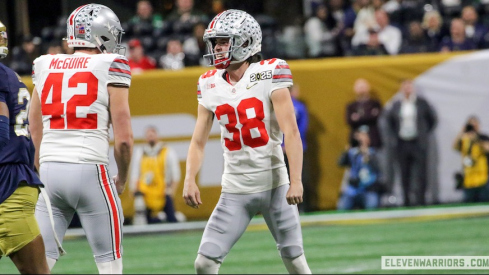It started with an indecent proposal.
If you could travel back in time equipped with all the knowledge you had acquired about the future, what would you do with it? Since this is Eleven Warriors we're not focused on killing Baby Hitler, buying penny stocks that end up hitting or manufacturing the courage to ask Ashley out back when you still had a shot. You irredeemable coward.
No, we're meddling with Ohio State sports moments while assessing if our world improves or suffers because of it. Last week the Time Squad embarked on its first assignment, which was to help Ryan Hamby catch a simple seam route pass against Texas in 2005.
Our objective here is to tinker with just one thing without leaving the future in shambles. This is incredibly hard to do. As expected, Time Squad Vol.I drew a number of enthusiastic requests, including:
- What if Ted Ginn doesn't get hurt after the first play of the 2007 BCS Championship?
- What if William Buford hits his 3-point buzzer beater to take down Kentucky in 2011?
- What if the replay crew for the 2019 Fiesta Bowl is incapacitated and removed from participating?
I'll go with Florida Still Wins, North Carolina and UConn Were Lurking and That Replay Crew Belongs in Prison Forever So Let's Do This Anyway, respectively. Time Squad is about how one moment can recast the future, not just one evening or even one season.
Consider late April 1974, when Neal Colzie, Archie Griffin, Pete Cusick, Arnie Jones, Kurt Schumacher and Steve Meyers - all teens or in their early 20s - were gathered together in the Union Cemetery two and a half miles north of Ohio Stadium. That single afternoon was over half a century in the making.
All six were exceptional college football players that had chosen Ohio State, which in 1974 was the same attractive destination for guys like that that it is today. OSU's quality football reputation was first established over the course of 24 fateful games completed 55 years earlier. Prior to that four year stretch, it was essentially a club team with big dreams.
Colzie, Griffin, Cusick, Jones and Meyers were the reigning Buckeye football captains. On that April afternoon they were serving as pallbearers at the funeral of a star player they had never met. In his college days, the departed had singlehandedly gotten the state so enthusiastic about the local team that Ohio Stadium was commissioned and built as a result.
If the Harley family hadn't left Chicago 1907 when their son Chic was an 8th grader, Ohio State football players wouldn't have been carrying him to his final resting place 67 years later in Columbus. He would have been buried in Illinois, where he spent nearly 70 years of his life. And Ohio Stadium's existence would be in doubt.
If Columbus East High School principal John Harlor had not offered the Harleys to allow Chic to live at his house for his senior year as they moved back to Illinois without their son, Buckeye football would look different today. Chic (it's short for Chicago, his name was Charles) probably would have played at Illinois alongside future Bears founder George Halas instead of becoming the most important Ohio State football player in program history.
Each of those moments led to six Buckeyes - who played their home games in a riverside cathedral that otherwise might never have been built - spending an April afternoon in Union Cemetery carrying the body of the man responsible for it. Time Squad, we're not touching that one.
Instead, this week we're heading to Columbus on November 19, 1988.
TIME SQUAD VOL.2 | MEND OF AN ERA

John Cooper's first season is remembered for two things, beating No.7 LSU on one of the most thrilling afternoons in Ohio Stadium history...and painful rebuilding. His Buckeyes finished 4-6-1, and it was clear he had a lot of work to do.
Their season-ending loss to Michigan was not viewed as a cautionary tale or a sign of things to come, in part because Ohio State played the Big Ten champs even that afternoon. They could have won that game. They should have won that game.
Before we get to our moment, let's rewind one year to Earle Bruce's final game in Ann Arbor, when Buckeye safety David Brown picked off Wolverine QB Demetrius Brown to set up a go-ahead touchdown.

Brown tracked that floater all the way into his bread basket. Not a bad return, either.
A year later, the Buckeyes were at home and had just taken a four-point lead with under two minutes left to play in the game. Michigan had two time outs left. It would need neither.
John Kolesar, arguably the greatest Michigan nemesis of the decade, took the Wolverines 100 yards in two plays. He returned Ohio State's kickoff 59 yards, and then was on the receiving end of a 41-yard toss from Demetrius Brown. As had been the case in 1987, this ball floated. It was a damn kite.
And just like that pick in Ann Arbor, David Brown was tracking the ball the entire time. You know how you'll scream turn your head around to an Ohio State defensive back locked in coverage? Unnecessary with Brown, who always had his eyes right and already had the longest interception return in conference history to his credit.
Consider what happens if he sets his feet and intercepts this one at the Ohio State goal line:
- The Coop-can't-beat-Michigan narrative is killed before it can begin.
- Ohio State has a two-game winning streak against Bo Schembechler while in program transition.
- One of loudest roars in Ohio Stadium history, cementing Brown and that game in rivalry lore.
- Kolesar's momentum took him into the end zone turf while everyone else was on the west side of the field. Brown only had the QB to beat to add a 99-yard TD to his 100-yard TD.
- Even if he didn't score, Michigan could only stop the clock twice with under 90 seconds left.
- Coop wins his very first Michigan game, with what will very easily be his worst Ohio State team.
- WCMH sports director Jimmy Crum probably doesn't call for Cooper's firing on-air three years later, which for those of you who didn’t experience the pre-Internet era was the early 1990s version of “breaking the Internet.”
- In-state recruits like Ricky Powers, Trent Zenkewicz, Alfie Burch, Ray Edmonds, Marcus Ray, Charles Woodson, Ki-Jana Carter, Jeff Hartings, Joe Jurevicious and Curtis Enis, all of whom were in play while Coop's job stability was swirling during the early 1990s, aren't as bothered by the instability in Columbus and might have been retained instead of playing for Ohio State's arch rival and "rival," respectively.
There doesn't appear to be any terribly negative or divergent consequences from positioning Brown to make the play he was just inches from making. Even with a win, Ohio State stays home that bowl season - but Coop's tenure and reputation are recast from the outset.
At worst, he goes 3-9-1 against Michigan. But maybe the Hall of Fame coach gets better footing at the program he permanently elevated, and is able to write a more palatable epitaph for his Ohio State tenure. And who knows what becomes of Michigan's beloved traitors. Rivalry momentum is a hell of a drug. Just ask Jim Tressel.
Verdict: Net positive. Time Squad, let's try this again in another space and era.



